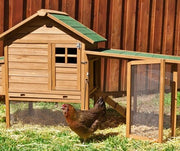Getting Into the Swing of Perches

Watching a group of young parakeets playing in a cage together can be very fascinating as many have very distinctive ways that they like to play. Some like to chew on a rope toy, others may babble to a mirror, two might even be doing a tug a war between them with a plastic chain, and there always seems to be at least one that is a true acrobat, hanging upside down from the cage bars, a toy, or a perch. The really amazing birds will actually go back and forth on a swing upside down, although most birds seem to prefer to swing without the added danger of hanging from their feet. No matter how a bird likes to play, they all need places to perch, and perches need to be offered not only in different sizes but different styles like swings and ladders to keep them healthy and in many cases entertained.
SIZING UP PERCHES
Most cages sold in stores come with two perches, usually wooden, and unfortunately of the same size in diameter. Birds must have perches with different diameters to keep their feet healthy and flexible, and at least three sizes if not more must be offered to achieve happy feet. Perches can be made out of many different materials including wood, plastic, and rope, and it is best to offer different materials when possible. Some perches actually offer many diameters in one perch, such as a wood or plastic branch or a perch with a wave shape, that are great for keeping bird’s feet healthy. Perches made out of materials that are porous, such as wood or rope, need to be replaced every six months, while those perches made of plastic can be washed well with soap and water and reused for much longer periods of time.
THE ROUGH STUFF
Perches made of cement or other roughened surfaces can be used to help keep a bird’s nails from growing too long. They can be especially helpful for finches such as canaries that seem to have a much faster nail growth rate than some of the parrot species. Avoid using sandpaper covers on pets perches, however, as they can roll under the feet and cause problems. But the cement and other permanent rough surfaced perches are great to use although if they are porous, they should to be replaced as often as the wood and rope perches.
BIG, BIGGER, BIGGEST
Obviously the larger the bird, the thicker the diameters of the perches that should be offered. Not only is this important for the comfort of the bird, but offering small perches to large parrots is basically giving them a chew toy. They will usually chew wood perches anyway no matter what the size, and may sometimes need to be replaced more often than every six months. Offering birds, especially the larger parrots, other items such as toys made out of different types of wood and rope, will often help keep the birds from chewing up their perches as quickly.
BIRDS ARE TRULY SWINGERS
Almost all of the popular caged birds, from finches to macaws, love to swing. Some may flutter their wings to get the swing going, others will lean back and forth, and some will grab a bar within reach of their bill and pull the swing forward and then let go. Some birds like to swing very lightly while others look like they could be whipped right off. No matter how they like to swing, be sure to place the swing so it can move freely and not hit the side of the cage, or a perch or toy. Some swings are now made so they have different diameters built in, or a roughened surface, or both, which is a great way to kill two birds with one stone, if you pardon the expression. Many swings also have some sort of toy attachments like rings, beads, or bells to make them even more interesting and fun for the pet bird.
GIVING AN ADDED LIFT
Ladders can be great devices to use for any birds, although those that would rather run around the cage instead of flying will use them more often. Birds that may have been injured in the leg or foot can also benefit from using a ladder to climb down to the food and then back up to a higher place where they all prefer to be perched. Ladders are also made of different materials, sizes, and some include toys as well. They can be very helpful for birds that like to come out and climb up to the top of a cage that has mainly vertical bars that would be hard to climb otherwise.
BIRD CAGE DECOR 101
All bird cage set ups should include at least three sizes of perches preferably made of different materials when possible. Avoid placing perches above one another so they will stay much cleaner, and not to put in too many as there needs to be some free space in a cage for a bird to flap its wings from time to time for exercise. When possible, a swing should also be offered as most birds will enjoy using them. Ladders are great for very large cages or cages that have vertical bars so the birds can move around easily. A cage is home for a pet bird and should be set up in a way that makes the bird comfortable and keeps them active. One can compare the use of perches in different diameters, along with swings and ladders, like furniture in a room, so they should be placed correctly and kept clean to help keep the bird healthy and their feet strong.
Written by Robyn Bright, avian behaviorist
Previous article

Next article

Related posts
View all-

What Can You Use Instead of Cat Litter?
Traditional cat litter is convenient, but it’s not the only option. Many cat owners look for alternatives to reduce waste, save money, or avoid chemicals found in clay-based kitty litter. Some options offer better odor control, while others are more eco-friendly or gentler on a cat’s paws.
Read Article -

How to Keep My Backyard Smelling Fresh
A clean backyard should smell fresh, unlike pet waste, smoke, or mold. Bad smells can linger, especially when dog poop, urine, or food scraps attract flies and bacteria. If your yard has a foul odor, it's time to take action. The first step is cleaning up pet feces, trash, or rotting food. A garden hose can wash away dirt and urine from artificial turf, patios, and decks. To neutralize odor, Use baking soda, white vinegar, and essential oils.
Read Article -

What Supplies Do First-Time Cat Owners Need?
Bringing home a new cat is exciting, but making them feel safe and comfortable takes more than love. First-time cat owners must prepare with the right supplies to ensure a smooth transition. From a litter box to cat food and a warm bed, having the basics ready can help your new kitty settle in faster. This guide covers everything a new cat owner needs to make their new pet feel at home.
Read Article



